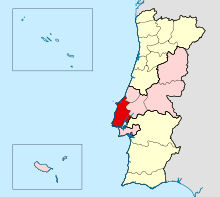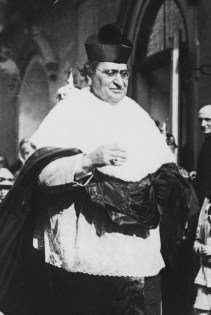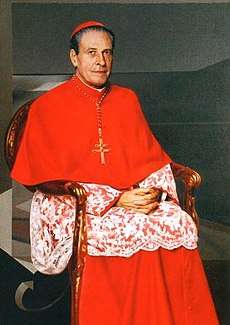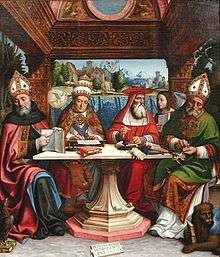Patriarchate of Lisbon
| Patriarchate of Lisbon Patriarchatus Ulixbonensis Patriarcado de Lisboa | |
|---|---|
|
| |
| Location | |
| Country |
|
| Statistics | |
| Area | 3,735 km2 (1,442 sq mi) |
| Population - Total - Catholics |
(as of 2015) 1,924,650 1,648,885 (86%) |
| Parishes | 284 |
| Information | |
| Denomination | Roman Catholic |
| Rite | Roman Rite |
| Established | 4th century |
| Cathedral | Lisbon Cathedral |
| Current leadership | |
| Pope | Francis |
| Patriarch | Manuel III |
| Suffragans |
Angra Funchal Guarda Leiria-Fátima Portalegre-Castelo Branco Santarém Setúbal |
| Auxiliary Bishops |
D. Nuno Brás da Silva Martins D. Joaquim Augusto da Silva Mendes D. José Augusto Traquina Maria |
| Map | |
 The Archdiocese of Lisbon shown in a darker red. | |
| Website | |
| http://www.patriarcado-lisboa.pt | |
The Latin Patriarchate of Lisbon (Latin: Patriarchatus Ulixbonensis) is a Metropolitan Archdiocese of the Latin Rite of the Roman Catholic Church based in Lisbon, national capital of Portugal.
Its cathedral archiepiscopal see is the Patriarchal Cathedral of St. Mary Major, in Lisbon. The Patriarchate also has three Minor Basilicas: the Basilica of Our Lady of the Martyrs and Basilica of the Most Sacred Heart of Jesus in Estrela, both in Lisbon; the Basilica of Our Lady and St. Anthony in Mafra; and two World Heritage Site monasteries: the Monastery of the Hieronymites, in Lisbon, and the Monastery of Saint Mary of Alcobaça, in Alcobaça
Patriarchate today
The patriarchate pastorally served, as per 2014, 1,648,885 Catholics (86% of 1,924,650 total) on 3,735 km² in 285 parishes and 604 missions, with 543 priests (291 diocesan, 252 religious), 84 deacons, 1,505 lay religious (401 brothers, 1,104 sisters) and 54 seminarians.
History

The diocese of Lisbon was created in the 4th century, but it lay vacant after 716 when the city was captured by the Moors, notwithstanding that there are references to Mozarabic bishops of the Mozarabic Rite in that period. The diocese was restored when the city was captured by king Afonso I of Portugal during the Second Crusade in 1147 during the siege of Lisbon. A crusader's account of that event refers to the local "elderly Bishop of the city" being slain "against all right and justice", by marauding Flemish and German crusaders, in direct defiance of the terms of the city's rendition.[1]
As Portugal grew in political importance and colonial possessions the jurisdiction of the Metropolitan of Lisbon expanded; Stadel says in his Compendium geographiae ecclesiasticae universalis (1712) that Coimbra, Leiria, Portalegre, Elvas, Funchal, Angra, Congo, St. James of Cape Verde, São Tomé, and Baia of All Saints were suffragans of Lisbon.[2] As a reward for its assistance against the Turks, Pope Clement XI in 1708 raised the Chapel of the Royal Palace to Collegiate rank and associated with it three parishes in the dioceses of Bragança and Lamego. Later, yielding to the request of King John V, he issued the Bull In Supremo Apostolatus Solio (22 October 1716) – known as the Golden Bull because the seal or bulla was affixed with gold instead of lead – giving the collegiate chapel cathedral rank, with metropolitical rights, and conferring on its titular the rank of patriarch.
The city of Lisbon was ecclesiastically divided into Eastern and Western Lisbon. The former Archbishop of Lisbon retained jurisdiction over Eastern Lisbon, and had as suffragan dioceses those of Guarda, Portalegre, St. James of Cape Verde, São Tomé, and São Salvador in Congo. Western Lisbon and metropolitan rights over Leiria, Lamego, Funchal and Angra, together with elaborate privileges and honours were granted to the new patriarch and his successors. It was further agreed between pope and king that the Patriarch of Lisbon should be made a cardinal at the first consistory following his appointment (Inter praecipuas apostolici ministerii, 1737).
The first Patriarch of Lisbon was Tomás de Almeida (1670–1754), formerly Bishop of Porto; he was raised to the cardinalate on 20 December 1737 by Pope Clement XII. There thus existed side by side in the city of Lisbon two metropolitical churches. To obviate the inconvenience of this arrangement Pope Benedict XIV (13 December 1740) united East and West Lisbon into one single archdiocese under Patriarch Almeida, who ruled the see until his death in 1754. The double chapter however remained until 1843, when the old cathedral chapter was dissolved by Pope Gregory XVI. It was during the patriarchate of Cardinal Almeida (1746) that the famous Chapel of Saint John the Baptist was built in Rome (1742–1747) at the expense of King John V and consecrated by Pope Benedict XIV, and then transported to and reconstructed in the Church of St. Roch in Lisbon. Patriarch Almeida is buried in the chancel of that church.
At what date the patriarchs of Lisbon began to quarter the tiara with three crowns, though without the keys, on their coat of arms is uncertain and there are no documents referring to the grant of such a privilege. By Apostolic letters dated 30 September 1881 the metropolitan of Lisbon claims as suffragans the Dioceses of Angola, St. James of Cape Verde, São Tomé, Egitan, Portalegre, Angra, Funchal.
Episcopal Ordinaries
.png)

.png)
Lisbon, being one of the oldest cities in Iberia, has had a rich ecclesiastical history, in which the ordinaries of Lisbon have held different titles, partially depending on the country/city's rulers and their political/colonial power.
Suffragan Bishops of Olisipo
- Saint Mantius (36) legendary
- Filipe Filoteu (92) legendary
- Pedro (I) (166) legendary
- Pedro (II) (213) legendary
- Jorge (260) legendary
- Pedro (III) (297) legendary
- Saint Gens of Lisbon (?) legendary
- Januário (300), legendary
- São Potâmio (c. 356)
- António (373)
- Neobrídio (430)
- Júlio (461)
- Azulano (?)
- João (500)
- Éolo (536)
- Nestoriano (578)
- Paulo (589)
- Goma or Gomarelo (610, 614)
- Viarico, Ubalico or Dialico (633, 636, 638)
- Nefrígio, Nefredo or Neofrídio (646)
- Cesário or César (656)
- Teodorico (666)
- Ara (683)
- Landerico (688, 693)
- Ildefonso (?)
After the Muslim invasion of Lisbon in 716, the see was vacant. The diocese was revitalized with the Siege of Lisbon in 1147, when the city was once again in Christian hands.
Suffragan Bishops of Lisbon
- Gilbert of Hastings (1147-1166)
- Álvaro (bishop) (1166-1185)
- Soeiro (I) Anes (1185-1210)
- Soeiro (II) Viegas (1210-1232)
- Vicente (1232)
- Paio Pais (1232-1233)
- João (I) Falberto (1233)
- Estêvão (I) Gomes (1234-1237)
- João (II) (1239-1241)
- Ricardo Guilherme (1241)
- Aires Vasques (1241-1258)
- Mateus (1259-1282)
- Estêvão (II) Anes de Vasconcelos (1284-1289)
- Domingos Anes Jardo (1289-1293)
- João (III) Martins de Soalhães (1294-1312)
- Frei Estêvão (III), O.F.M. (1312-1322)
- Gonçalo Pereira (1322-1326)
- João (IV) Afonso de Brito (1326-1341)
- Vasco (I) Martins (1342-1344)
- Estêvão (IV) de la Garde (1344-1348)
- Teobaldo de Castillon (1348-1356)
- Reginaldo de Maubernard (1356-1358)
- Lourenço Rodrigues (1359-1364)
- Pedro Gomes Barroso, o Jovem (1364-1369)
- Fernando Álvares (1369-1371)
- Vasco (II) Fernandes de Toledo (1371)
- Agapito Colona (1371-1380), 1378 Cardinal
- João (V) de Agoult (1380-1381) - named bishop of Lisbon by pope Urban VI (pope in Rome)
- Martinho de Zamora (1380-1383) - named bishop of Lisbon (and Cardinal in 1383) by Antipope Clement VII (pope in Avignon)
- João (VI) Guterres (1381-1382) - named bishop of Lisbon by pope Urban VI (pope in Rome)
- João (VII) Anes (c. 1383-1394)
Metropolitan Archbishops of Lisbon
- João (I) Anes (1394-1402)
- João (II) Afonso Esteves da Azambuja (1402-1415)
- Diogo Álvares de Brito (1415-1422)
- Pedro de Noronha (1424-1452)
- Luís Coutinho (1452-1453)
- Cardeal D. Jaime de Portugal (1453-1459)
- Afonso (I) Nogueira (1459-1464)
- Cardeal D. Jorge da Costa (1464-1500)
- Martinho da Costa (1500-1521)
- Cardinal-Infante D. Afonso (II) de Portugal (1523-1540)
- Fernando de Meneses Coutinho e Vasconcelos (1540-1564)
- Cardinal Infante D. Henrique de Portugal (1564-1570)
- Jorge de Almeida (1570-1585)
- Miguel de Castro (1586-1625)
- Afonso (III) Furtado de Mendonça (1626-1630)
- João (III) Manuel de Ataíde (1633)
- Rodrigo da Cunha (1635-1643)
- António de Mendonça (1670-1675)
- D. Luís de Sousa (1675-1702)
- João (IV) de Sousa (1703-1710)
Latin Patriarchs of Lisbon
- Tomás de Almeida (1716–1754)
- José (I) Manoel da Câmara (1754–1758)
- Francisco (I) de Saldanha da Gama (1758–1776)
- Fernando de Sousa da Silva (1779–1786)
- José (II) Francisco Miguel António de Mendonça (1786–1818)
- Carlos da Cunha e Menezes (1819–1825)
- Patrício da Silva (1826–1840)
- Francisco (II) de São Luís (Francisco Justiniano) Saraiva (1840–1845)
- Guilherme Henriques de Carvalho (1845–1857)
- Manuel (I) Bento Rodrigues da Silva (1858–1869)
- Inácio do Nascimento de Morais Cardoso (1871–1883)
- José (III) Sebastião de Almeida Neto (1883–1907)
- António (I) Mendes Belo (1907–1929)
- Manuel (II) Gonçalves Cerejeira (1929–1971)
- António (II) Ribeiro (1971–1998)
- José (IV) da Cruz Policarpo (1998–2013)
- Manuel (III) José Macário do Nascimento Clemente (2013–)
Ecclesiastical province
The suffragan sees of the Metropolitan are :
See also
References
- ↑ Osbernus. "Osbernus: De expugnatione Lyxbonensi, 1147 [The Capture of Lisbon]". Internet Medieval Sourcebook. Fordham University. Archived from the original on August 14, 2014.
- ↑ Johann Karl : Von Stadel (1712). Compendium geographiae ecclesiasticae universalis, in quo patriarchatuum, archi-&-episcopatuum, per totum orbem diffusorum modernus status exponitur, cum rebus notabilioribus provinciarum. Compositum ab abbate Joanne Carolo a Stadel . sumptibus auctoris. pp. 175–176.
Sources and external links
| Wikimedia Commons has media related to Patriarchate of Lisbon. |
- GCatholic.org, with Google map – data for all sections
- Patriarch of Lisbon at catholic-hierarchy.org
- Official website (in Portuguese)

- Westermann, Großer Atlas zur Weltgeschichte
_-_Sebasti%C3%A3o_Lopes_(attrib.)%2C_Museu_de_Arte_Sacra_da_S%C3%A9_de_%C3%89vora_(cropped2).png)
.png)


